crysalla TRAITS
Return to Crysalla Species Directory
overview
Crysalla are a highly adaptive species that have evolved to live on all of Siablan, and thus, very greatly in appearance.
- Traits do not require potions to alter. Traits are free to use within your MYO limits.
Dermis
A Crysalla is covered snout to talon in scaly skin that they regularly shed and consume as they grow. However, these scales can be varied and sorted into different types, and come in any shape, pattern, or size, as well as be tubercular, platelike, or imbricate.
A diet high in minerals and protein will make scales shinier. Colorful, reflective scales are considered attractive to Crysalla.
- The scaleless mutation causes a Crysalla to not develop scales, exposing its bare, sensitive skin.
Scales
Granular
- Bumpy, raised scales of varying size and shape.

keeled
- Scales with a central ridge, can be platelike or imbricate.

Dermal growths
Scutes
- Dermal growth similar to scales. Vary in size, from small bumps to prominent ridges.

osteoderms
- Bony deposits that form plates or scales from the dermis. They may vary in size and shape, and grow anywhere on the body.

spines
- Long, bony projections from the skeleton itself. They may come in any shape or grow from any direction.

Plates
- Bony projections from the skeleton evolved from osteoderms. They vary in size and shape.
Filaments
Crysalla are an incredibly diverse species, adapted for all of the harsh climates of Siablan. They may grow feathers, fur, pycnofibers, hair, or wool anywhere on their bodies, in any color.
feathers
- Can grow anywhere on the body, and come in any shape or size, zip or unzipped, from downy, to flight, to display feathers, to oily, water repellant feathers. All Crysalla will have leather wings, however they may also have feathers coating either side of them.
- Frillback is a mutation that causes feathers to curl.

fur
- Can grow anywhere on the body, at any length and type, such as wiry, downy, oily, etc.
- Rex is a mutation that causes fur to curl.
- Yeti is a mutation that causes the entire body to be covered in fur.

Pycnofibers
- Can grow anywhere on the body, including wings, dense hairlike filaments. They are more common in Presalla, and are few and far in between in modern Crysalla, being mostly replaced with fur and hair.
- Overgrowth is a mutation that causes the entire body to be covered in pycnofibers.

hair
- Perhaps the most naturally diverse and versatile filament, hair can grow anywhere on the body, and to any length, and come in any hair type from 1a-4c, from dry, coarse, or oily and water repellant. Hair can be tied, braided, shaved, or otherwise styled any way a Crysalla wants.
- Locs is a mutation that causes the hair to naturally coil into dreadlocks.
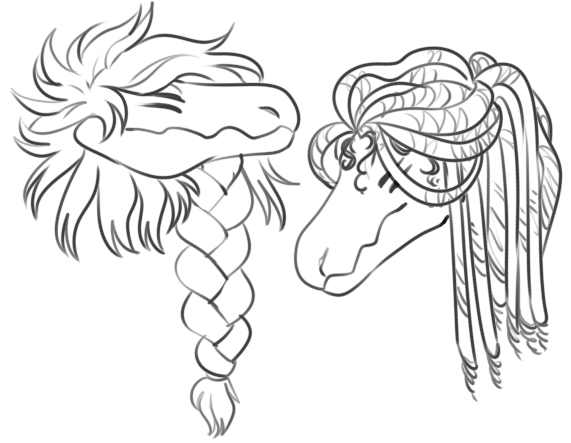
wool
- The rarest filament type is actually a mutation in of itself. Wooly allows the Crysalla to grow their own wool anywhere on the body, which regularly regrows and can be sheared and spun into cloth. Wool thickness will vary by Crysalla, but it is most common in Crysalla inhabiting cold climates. Crysalla wool is worth its weight in gold, and its cloth is said to be the softest of its kind.

Horns
Crysalla horns can vary in color, shape, size, amount, and even composition. Any horn type is capable of growing singularly or in multiple sets on the head. Horns may look like anything.
Bone
- “True” horns, a permanent extension of the skull with a keratin covering.
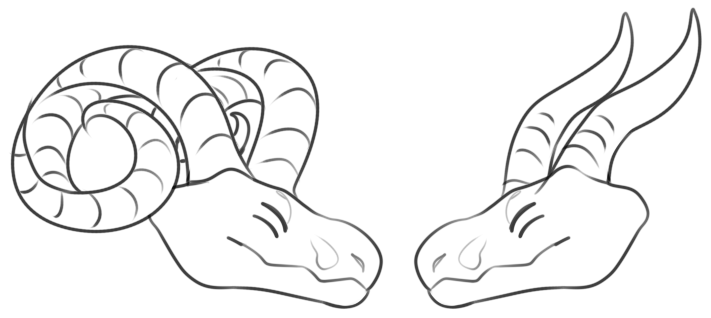
Keratinous
- Composed entirely of keratin and grow continuously, must be trimmed.
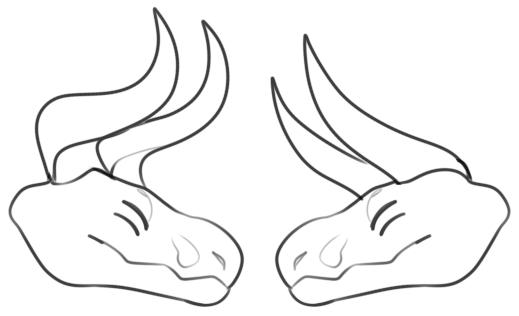
ivory
- Composed of dentine and collagen, and highly prized material.

antlers
- Dead bone without a horn or skin covering that are periodically shed and regrown.

ossicones
- Bony horns covered in skin with scales or fur.
![]()
crests
- Bony growths on the skull that vary in shape and size.

Crystallized
- If you recall, Crysalla bones are highly mineralized. In addition to all of these types, a Crysalla can also have crystallized horns, which are part of the skull.

Crystals
Crysalla are known for their crystal growths. While all Crysalla have a Soul Stone, not all Crysalla will possess the genes to grow additional crystal growths. Crysalla are born without any growths, and will grow them as they come of age, and well into maturity. Crystal growths will periodically shed throughout a Crysalla’s lifetime, and can be broken off or surgically removed.
- Crysalla crystals are unique compared to their natural counterparts in that genes affect the size, shape, color, and species of the crystal. It is common for crystals to grow in a “cut” fashion, smooth, or prismatic, regardless of the formation of the natural mineral.
- Crysalla crystals can store magical energy for later siphoning and use. Crysalla with more mana will often grow more crystals.
- A Crysalla may grow any type of crystalling mineral, as well as several noncrystalline minerals, such as bloodstone, obsidian, or goldstone. In addition to geologic minerals, some Crysalla can produce organic gemstones, such as amber, jet, pearls, or ammolites.
- Naturally poisonous minerals are toxic to ingest, and are genetically linked with the Venom mutations.
point
- Rhomboid, most common orientation.

cube
- All right angles

raw
- Uneven, uncut appearance

pyrimidine
- Pyramid point, triangular or square
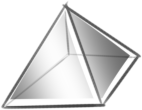
rounded
- Smooth, circular or ovalline appearance

cut
- Shaped appearance, any shape, including stars, hearts, or diamonds

cluster
- Multiple irregular growths from the same site

wand
- Long, uneven projection

twin
- Two or more crystals joined together

merkaba
- Pointed star shape, perhaps the rarest crystal type

druzy
- Multiple small, irregular growths

rosette
- Rounded clusters

Heads
Crysalla come in all shapes and sizes, and their faces are no different. However, all Crysalla will have a jagged beak and four pure white eyes, unless a mutation is present. All Crysalla have a rudimentary photosensitive parietal eye on their forehead that helps them navigate with their true eyes closed.
Crysalla skulls have a large cranial cavity, and their bite can exert a force of 5,000 to 10,000 PSI. Crysalla primarily hunt by ambushing and crushing their prey in their jaws. Their beaks are highly mineralized and capable of crunching up the hardest crystals and rocks for consumption.

- Two Eyes is a mutation in which only two eyes develop.
- No Eyes is a mutation in which the eyes fail to develop.
- Colored Eyes is a mutation in which the eyes are a solid color other than white.
- Straight Beak is a mutation in which the beak is smooth, without its characteristic jags.
standard
- Average head shape of a Crysalla

rounded
- “Egg” shaped head, no dip between snout and forehead

slender
- Prominent dip between snout and forehead

brachycephalic
- Short, upturned snout

dolichocephalic
- Long, crocodile-like snout

jagged
- Long, with more prominent beak jags

blunt
- Rounded forehead with square front.

rectangular
- Prominent forehead ridge, square shaped snout

jut
- Protruding chin

beak
- Slender, corvidesque beak

Wings
Crysalla wings are large, attached behind their shoulder to move independently, and the membrane extends down along the tail.
- Crysalla wings have four fingers and a thumb, unless the mutation Polydactyly is present and affecting the wing digits.
- Crysalla have thick paw pads on the ventral side of their wings, which they use to push off the ground when launching themselves into the air.
- Crysalla wings come in various different shapes due to genetics for different flight styles.
- As previously stated, feathers can cover the insides or outsides of the wings. These can be used for insulation or merely decoration.
- Wing membranes can be pierced, trimmed, or have holes cut into them for decoration and expression.
- Wing membranes are opaque, unless the mutation Glasswing is present, which makes the wing membrane translucent.
- Polydactyly may affect one, multiple, or all limbs of the Crysalla, not just the wings, and come in varying amounts of extra digits.
- The Swallowtail mutation causes long trails of membrane to extend from the wings, which can vary in shape, amount, and size.
- Wings can have feathers, but they will always have membranes and fingers.

STANDARD
- Built like a bird of prey; optimized for speed, agility, and raw strength for lifting their heavy skeleton into the air

ACTIVE SOARING WINGS
- Long and narrow, adapted for soaring without flapping for long periods of time over long distances over water to conserve energy
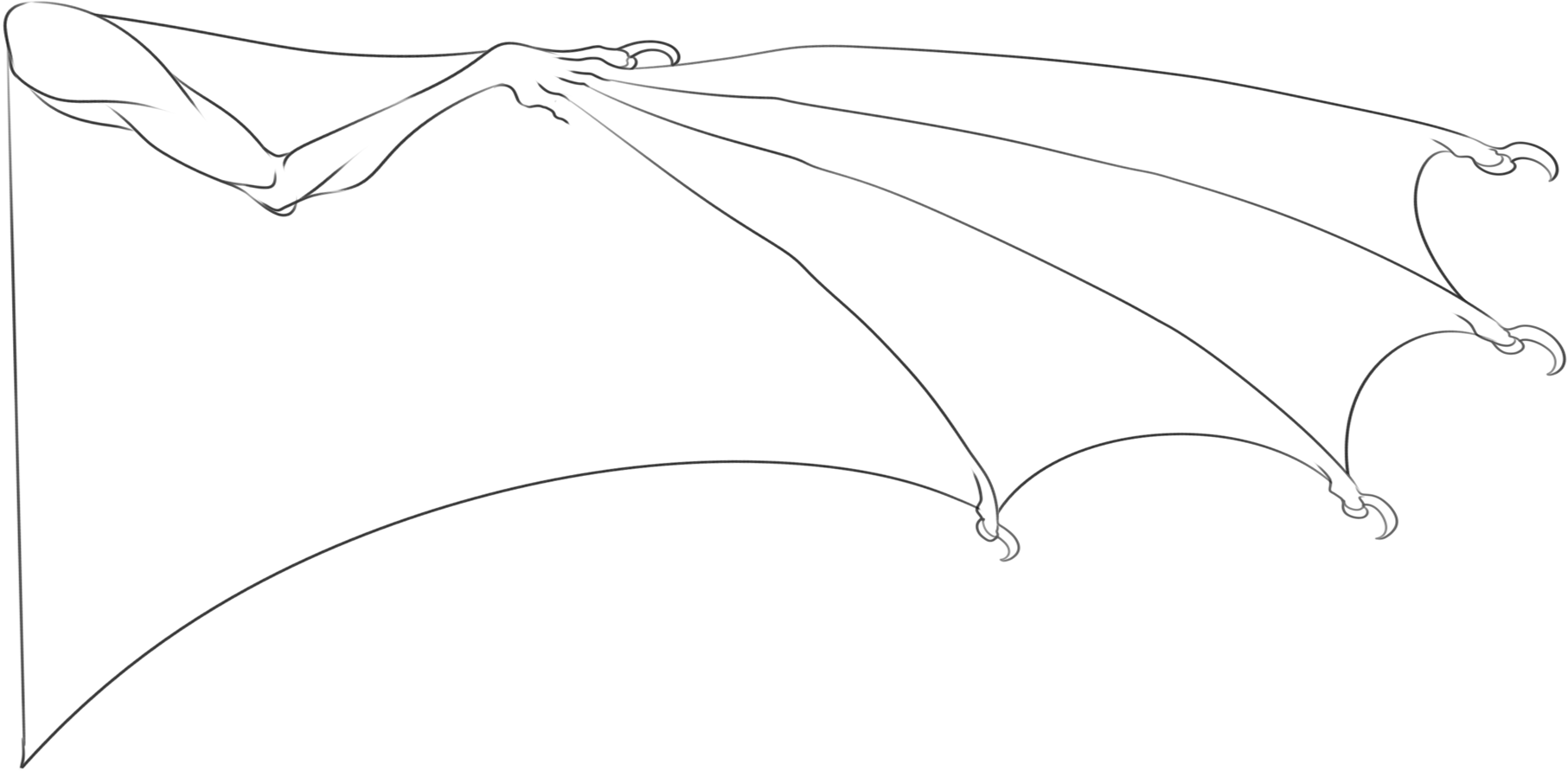
PASSIVE SOARING WINGS
- Long and broad, capable of soaring without reliable wind currents

elliptical wings
- Short and wide, capable of fast and tightly controlled flight, and easy maneuverability through obstacles like trees
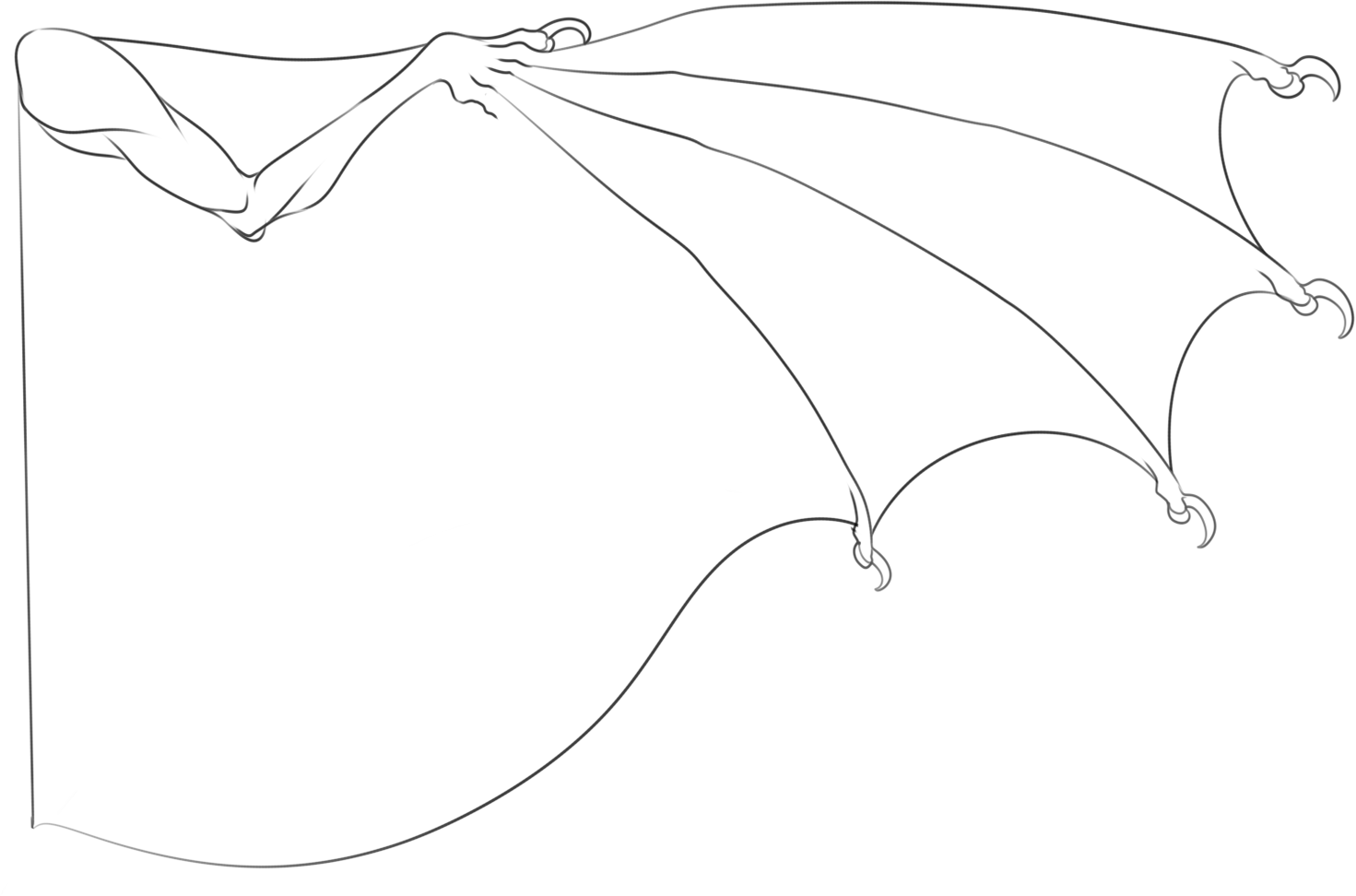
hovering wings
- Smaller relative to body size, capable of sustained hovering, rapid wingbeats, and tightly controlled flight

dwarf wings
- Actually a mutation affecting the wing development, the result is wings too small for any powered flight, and are only capable of short gliding from high places.

Tails
Tails vary widely by Crysalla. While some are more common with certain body types, such as Serpentine tails and the body shape of the same name, or Gecko tails for dwarves, this is not a strict assortment.
- The Polycaudal mutation allows for multiple tails, separated or split, up to three in number.
Standard
- The standard Crysalla tail is long and thick, and slightly stiff, to offset the weight of the body. The wing membrane extends to about half of it, and it has a prominent dip of the hip bone.

serpentine
- The serpentine Crysalla tail is longer and thinner, and highly flexible. The wing membrane only extends for a third of it.

whip
- The whip tail is extremely long and thin, and capable of snapping in the air with a loud crack! The wing membrane only extends for a quarter of it, and the hip bone is shallower.

chameleon
- The chameleon tail is prehensile and capable of carrying objects or supporting the Crysalla’s weight when hanging from branches. It’s extremely strong! The wing membrane only extends for a third of it.

gecko
- The gecko tail is short, thick, and stores large amounts of fat. It’s built to feed a Crysalla in times of food scarcity, specially adapted for desert environments. The wing membrane extends for half of it.

bobtail
- The Bobtail is a mutation affecting both the tail and the wing membrane. The tail itself is shortened to a nub, while the wing is shortened to the thigh. Crysalla with the bobtail mutation are typically less coordinated both on the ground and flight.

tailless
- Tailless - The Tailless mutation causes the tail to never develop, and the wing membrane to be shortened to the thigh. This causes balance issues and less coordinated flight.
Limbs
Crysalla hands have four fingers, rough pads for walking on rough terrain, and mineralized claws. Crysalla hands have an opposable thumb, and dextrous wrists.
Crysalla feet have four toes and a non-opposable dew claw.

Crysalla wings have four fingers and a thumb, and rough pads on their palm for pushing off of the ground.
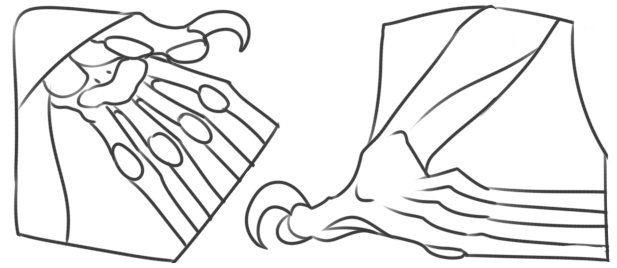
Digits
Crysalla digit length varies by individual, and affects all six limbs.
Standard
- Standard length, average hand

Brachydactyly
- Shortened, fatter fingers

Arachnodactyly
- Elongated, thinner fingers

Aquilla Traits
Aquilla are capable of breeding with other Crysalla, and may pass on the distinct Aquilla traits, Gills, Fins, Webbed Toes, or Unique Scales. Aquilla may have any of the same mutations as standard Crysalla.
Scales
Originating only in Aquilla, these three scale types have now been added to the modern Crysalla gene pool.
Cycloid
- Overlapping, round scales
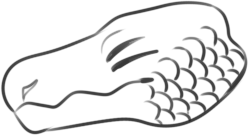
placoid
- Sharp denticles, mutated “teeth”

ganoid
- Rhomboidal, fit together like a jigsaw rather than imbricate

Gills
Evaginated respiratory surfaces for breathing water. The characteristic staple of Aquilla, they can vary in number, placement, and type.
Internal Gills
Narrow slits typically open along the neck, and can extend down the line of the ribcage. Range from small semicircles to shaped openings

external gills
- Gills present on frilled stalks protruding from the head. Range from short nubs to trailing tendrils

Fins
Typical of Aquilla, fins are webbing linked by cartilaginous spines. Fins can vary in size, shape, and placement anywhere on the body, and aid in maneuvering in the water.
- Venomous Spines is a mutation in which the Aquilla grows venomous spines on their fins. Can be placed anywhere on the body.
Standard fins are simple webbing and spines, but of course fins often change their shape due to their placement. Body fins may grow anywhere on the body, and may come in different shapes, and can be mixed
Lobed
- Simple webbing and spines

Ray
- Soft, ray fins.

Cartilaginous
- Cartilaginous fins.

Webbing
Characteristic of Aquilla limbs, webbed toes allow for easier movement in the water. They can range in length.
standard
- Standard toe length, good for all around swimming

brachydactyly
- Shortened toes, better for swimming in the shallows

arachnodactyly
- Elongated toes, better for deep-sea swimming


